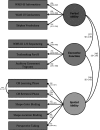Developing a Spatial Navigation Screening Tool Sensitive to the Preclinical Alzheimer Disease Continuum
- PMID: 31197326
- PMCID: PMC6849466
- DOI: 10.1093/arclin/acz019
Developing a Spatial Navigation Screening Tool Sensitive to the Preclinical Alzheimer Disease Continuum
Abstract
Objective: There remains a need for a non-invasive and cost-effective screening measure that could be administered prior to the provision of a lumbar puncture or positron emission tomography scan for the detection of preclinical Alzheimer disease (AD). Previous findings suggest that a hippocampally-based spatial navigation task may be effective for screening individuals for the preclinical AD continuum (i.e., low cerebrospinal fluid (CSF) Aβ42). Unfortunately, this task took 1.5-2 hours to administer, which would be time-prohibitive in a clinical setting. Therefore, the goal of this study was to compare psychometric properties of six spatial navigation-related tasks in order to take the next steps in developing a clinically appropriate screening measure.
Methods: Psychometric properties (i.e., reliability, diagnostic accuracy, validity) of a modified version of the cognitive mapping task, two binding tasks, a visual perspective taking task, and self- and informant report versions of a questionnaire were examined in a sample of 91 clinically normal (CN) individuals. CSF Aβ42 and ptau181 were available for 30 individuals.
Results: The learning phase of the cognitive mapping task and the self-report questionnaire were sensitive to identifying individuals in the preclinical AD continuum (93% and 87% sensitivity, 60% and 67% specificity, respectively). These two measures also demonstrated good test-retest stability (intraclass correlation coefficients = .719 and .838, respectively) and internal consistency (Cronbach's αs = .825 and .965, respectively).
Conclusions: These findings suggest that a self-report questionnaire and aspects of a cognitive mapping task may be particularly appropriate for development as screening tools for identifying individuals in the preclinical AD continuum.
Keywords: amyloid; cognition; hippocampus; ptau; reliability; validity.
© The Author(s) 2019. Published by Oxford University Press. All rights reserved. For permissions, please e-mail: journals.permissions@oup.com.
Figures



Similar articles
-
Clinical utility of self- and informant-reported memory, attention, and spatial navigation in detecting biomarkers associated with Alzheimer disease in clinically normal adults.J Int Neuropsychol Soc. 2024 Mar;30(3):232-243. doi: 10.1017/S1355617723000528. Epub 2023 Aug 29. J Int Neuropsychol Soc. 2024. PMID: 37642015
-
Anti-Correlated Cerebrospinal Fluid Biomarker Trajectories in Preclinical Alzheimer's Disease.J Alzheimers Dis. 2016;51(4):1085-97. doi: 10.3233/JAD-150937. J Alzheimers Dis. 2016. PMID: 26967213
-
Spatially distinct atrophy is linked to β-amyloid and tau in preclinical Alzheimer disease.Neurology. 2015 Mar 24;84(12):1254-60. doi: 10.1212/WNL.0000000000001401. Epub 2015 Feb 25. Neurology. 2015. PMID: 25716355 Free PMC article.
-
The application of cerebrospinal fluid biomarkers in early diagnosis of Alzheimer disease.Med Clin North Am. 2013 May;97(3):369-76. doi: 10.1016/j.mcna.2012.12.012. Epub 2013 Feb 1. Med Clin North Am. 2013. PMID: 23642576 Review.
-
Simultaneous analysis of cerebrospinal fluid biomarkers using microsphere-based xMAP multiplex technology for early detection of Alzheimer's disease.Methods. 2012 Apr;56(4):484-93. doi: 10.1016/j.ymeth.2012.03.023. Epub 2012 Apr 6. Methods. 2012. PMID: 22503777 Review.
Cited by
-
Different Profiles of Spatial Navigation Deficits In Alzheimer's Disease Biomarker-Positive Versus Biomarker-Negative Older Adults With Amnestic Mild Cognitive Impairment.Front Aging Neurosci. 2022 Jun 2;14:886778. doi: 10.3389/fnagi.2022.886778. eCollection 2022. Front Aging Neurosci. 2022. PMID: 35721017 Free PMC article.
-
Spatial navigation questionnaires as a supportive diagnostic tool in early Alzheimer's disease.iScience. 2024 Apr 26;27(6):109832. doi: 10.1016/j.isci.2024.109832. eCollection 2024 Jun 21. iScience. 2024. PMID: 38779476 Free PMC article.
-
Evaluation of a cognition-sensitive spatial virtual reality game for Alzheimer's disease.Med Biol Eng Comput. 2025 May;63(5):1355-1365. doi: 10.1007/s11517-024-03270-1. Epub 2024 Dec 26. Med Biol Eng Comput. 2025. PMID: 39725762
-
Psychometric properties and normative data of the Italian version of the Cognitive Function at Work Questionnaire: a screening tool for detecting subjective cognitive complaints at work.Neurol Sci. 2024 Jun;45(6):2593-2603. doi: 10.1007/s10072-023-07265-y. Epub 2023 Dec 29. Neurol Sci. 2024. PMID: 38155286
-
Evaluating measurement properties of subjective cognitive decline self-reported outcome measures: a systematic review.Syst Rev. 2022 Jul 18;11(1):144. doi: 10.1186/s13643-022-02018-y. Syst Rev. 2022. PMID: 35850915 Free PMC article.
References
-
- Akaike H. (1987). Factor analysis and AIC. Psychometrika, 512, 317–332.
-
- Algase D., Son G. R., Beel-Bates C., Song J., Yao L., Beattie E., et al. . (2007). Initial psychometric evaluation of the Wayfinding Effectiveness Scale. Western Journal of Nursing Research, 29, 1015–1032. - PubMed
-
- Bentler P. M. (1990). Comparative fit indexes in structural models. Psychological Bulletin, 107, 238–246. - PubMed
MeSH terms
Substances
Grants and funding
LinkOut - more resources
Full Text Sources
Medical

